Walking Shoes for Babies – Picking The Perfect Pair of Shoes for your Baby
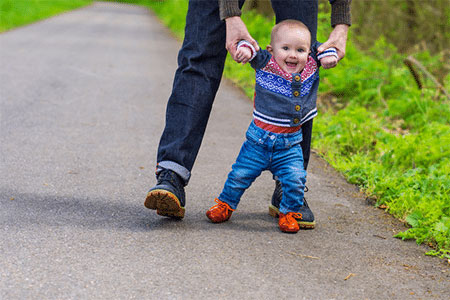
Are you looking for the perfect pair of first walking shoes for your baby? Did you know that the first pair of walking shoes play a key role in helping your baby walk confidently? The best walking shoes for babies are lightweight, flexible, have oversized openings, and are capable of accommodating different foot shapes.
It’s important to understand that it’s always better to allow your baby to crawl or walk barefoot inside the house. This is the best thing we can do to promote healthy muscle development. Your baby will only need shoes when you go outside to the shopping mall, the playground, or any activity that involves your baby taking steps outside the house.
One of the most common questions I get from parents is what type of shoes they need to provide for a baby that is learning how to walk? Let’s find out!
First Walking Shoes for Babies – Lightweight, Flexible, and Sensory Pods!
Your baby’s first walking shoes must be lightweight, flexible, and provide sensory pods on the sole so your baby can get a better sense of the ground. However, the most important thing to keep in mind is making sure that you provide your baby with the correct shoe size.
Most babies tend to have wide or extra wide feet, as they might carry some baby fat.
As your baby lifts its heel to take a step, there must be some degree of easy flexibility at the ball to step forward without resistance from the sole. Keep in mind that your baby, unlike older children, lacks the body weight (strength) to bend a firmer sole. That is the main reason why first walking shoes need to be soft and flexible!
Your baby’s first walking shoes should have a sole that must retain its shape with wear. As to material, a leather outsole is unquestionably the best to fulfill these functions. Shoes with leather soles are found in good quality shoes, like the ones I will recommend shortly.
When it comes to baby shoes, there is such thing as a sole being too soft. A sole that is too soft, such as a soft-sole slipper, will not hold its shape with wear. It lacks that important quality of lateral stability.
Your baby’s shoes must provide good lateral stability because you will notice how your baby will grab onto furniture and move side to side.
Before you buy your baby his or her first pair of walking shoes, grab the shoes and make sure they bend in the right places just like in the picture below:
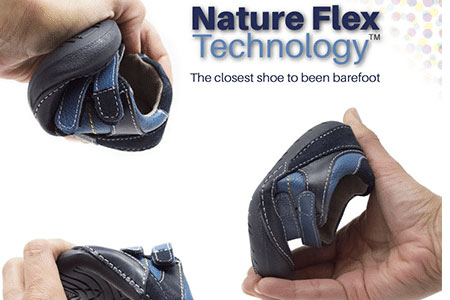
I have put together a selection of the best first walking shoes for babies who are learning how to walk, but let’s make sure that you know your baby’s exact foot size. You won’t be able to order the correct shoe size online if you don’t know your baby’s foot size to begin with.
How to Retrieve Your Child’s Exact Foot Length and Shape
Take a look at an article where I describe the simplest, yet most effective way to figure out your baby’s foot size from home.
In that article, I help parents determine their baby’s exact foot size and whether the baby has narrow, medium, wide, or extra wide feet. I also will be able to tell you whether your baby has a high instep or not.
The Baby (9-15 months) – Learning How to Walk
During this stage, your baby should start becoming an independent walker. If your baby is crawling and standing up with the assistance of holding into things this might be a good time for getting the first pair of shoes.
The appropriate pair of shoes at this age is what I describe as transition shoes. These types of shoes should bend in half and twist, and they should be very lightweight and most flexible so your children’s muscles can develop properly.
Your baby’s tiny toes are constantly wiggling, which is nature’s way of exercising the foot for development. Toe gripping is also essential for gait balance when the child starts to walk. Thus the obvious importance of baby shoes having ample grow room and wiggle space in the toe area.
Some parents believe that once they fit the first pair of walking shoes for their babies, they will immediately start walking. Eighty percent of the time this will not happen. Once we fit the first pair of walking shoes, babies lose the sense that they had to the ground, so it takes longer to adjust.
I can tell you that most times after I fit babies for their first pair of walking shoes, it looks like their feet were nailed down to the ground, as they refuse to move and will stand in the same position waiting for the parents to rescue them! This is totally normal.

After a week or so of wearing the shoes, babies should have no problem walking. Babies will begin to learn how to balance themselves with their arms, that is the reason why they should not be holding onto anything when attempting to take those first steps.
Below you can find the best first walking shoes for a baby that is learning how to walk. These shoes are all available in medium (M), wide (W), and extra wide (XW). Disclosure: Some links in this post may be affiliate links and we may receive a small commission (at no extra cost to you) when you click our links and make purchases. This allows us to create free content and resources for many families around the world.
The Best First Walking Shoes for Babies
Boys
- Shoe style SRT SM Artie by Stride Rite
- Available in medium, wide, and extra wide widths
- Rounded edges to decrease stumbles and falls
- APMA approved and built for first-time walkers
- Order this shoe a whole size larger than your baby’s current foot size
- Shoe style 2510 Racer by Tsukihoshi
- Fits medium and wide feet
- Heel stabilizer provides lateral stability
- Removable insoles
- Machine washable
- Order this shoe the same size as your baby’s foot size (shoe fits long)
- Shoe style Wes by Stride Rite
- Available in medium, wide, and extra wide widths
- Seamless construction cradle the baby’s natural shape
- Flexible, rounded, slip-resistant soles
- APMA approved
- Order this shoe a whole size larger than your baby’s current foot size
- Shoe style SM Adamby Stride Rite
- Available in medium and wide widths
- Seamless construction cradle the baby’s natural shape
- Flexible, rounded, slip-resistant soles
- Foam padding placed around the ankle collar and under the tongue for an incredibly comfortable fit and feel
- Order this shoe a whole size larger than your baby’s current foot size
- Shoe style Stevie II by See Kai Run
- Fits medium and wide feet
- Rubber outsole is flexible yet durable and provides the needed traction for first steps
- Padded heel and tongue keeps the baby’s feet comfortable
- Wide openings make on and off quick and easy
- Order this shoe half a size larger than your baby’s current foot size
- Shoe style Martin by Stride Rite
- Available in medium and wide widths
- Seamless construction cradle the baby’s natural shape
- Flexible, rounded, slip-resistant soles
- Oversized opening and pull tab on the back offer easy on and off
- Order this shoe a whole size larger than your baby’s current foot size
- Shoe style Soft Motion Wally by Stride Rite
- Available in medium and wide widths
- Seamless construction that cradles the foot’s natural shape
- APMA approved
- Oversized opening for easy-on
- Order this shoe half a size larger than your baby’s current foot size
- Shoe style Soft Motion Kylo by Stride Rite
- Available in medium, wide, and extra wide widths
- Oversized opening for easy on and off
- Flexible, rounded, slip-resistant soles encourage natural motion and help improve balance
- Machine washable
- Order this shoe a whole size larger than your baby’s current foot size
- Shoe style SRT Elliot by Stride Rite
- Available in medium, wide, and extra wide widths
- 100% leather made
- Sensory pods to feel the ground beneath for better traction and grip
- Lace-up closure
- Order this shoe a whole size larger than your baby’s current foot size
Girls
- Shoe style SM Adalyn by Stride Rite
- Available in medium, wide, and extra wide widths
- Oversized opening for easy on and off
- Flexible, rounded, slip-resistant soles encourage natural motion and help improve balance
- APMA approved
- Order this shoe a whole size larger than your baby’s current foot size
- Shoe style Zips Runner by Stride Rite
- Available in medium, wide, and extra wide widths
- Oversized opening for easy on and off
- Padded tongue and collar
- APMA approved
- Order this shoe a whole size larger than your baby’s current foot size
- Shoe style Susie Mary Jane by See Kai Run
- Fits medium and wide feet
- Black patent leather upper with full leather lining and insole
- Awarded the Seal of Acceptance from the American Podiatric Medical Association (APMA)
- Order this shoe half a size larger than your baby’s current foot size
- Shoe style Soft Motion Baby by Stride Rite
- Available in medium, wide, and extra wide widths
- Oversized opening for easy on and off
- Flexible, rounded, slip-resistant soles encourage natural motion and help improve balance
- APMA approved
- Order this shoe half a size larger than your baby’s current foot size
- Shoe style Stevie II by See Kai Run
- Fits medium and wide feet
- Rubber outsole is flexible yet durable and provides the needed traction for first steps
- Padded heel and tongue keeps the baby’s feet comfortable
- Wide openings make on and off quick and easy
- Order this shoe half a size larger than your baby’s current foot size
- Shoe style Thompson by Stride Rite
- Available in medium and wide widths
- Oversized opening for easy on and off
- Flexible, rounded, slip-resistant soles encourage natural motion and help improve balance
- APMA approved
- Order this shoe a whole size larger than your baby’s current foot size
- Shoe style SRT Elliot by Stride Rite
- Available in medium, wide, and extra wide widths
- 100% leather made
- Sensory pods to feel the ground beneath for better traction and grip
- Lace-up closure
- Order this shoe a whole size larger than your baby’s current foot size
- Shoe style Soft Motion Baby by Stride Rite
- Available in medium, wide, and extra wide widths
- Over-sized opening for easy on/off
- APMA approved and built for first-time walkers
- Order this shoe a whole size larger than your baby’s current foot size
- Shoe style Ryder II by See Kai Run
- Fits medium and wide feet
- Rubber outsole is flexible yet durable and provides the needed traction for first steps
- Padded heel and tongue keeps the baby’s feet comfortable
- Wide openings make on and off quick and easy
- Order this shoe half a size larger than your baby’s current foot size
To some mothers, new shoes often look giant on the baby’s foot. I often mention that baby shoes sometimes appear large to the eye, but the shoes are the right size needed for this fast-growing foot.
The question of durability is completely unimportant in infant shoes, since they never wear out the shoes because of how fast they grow.
Did you know that getting the right socks for your baby has the same importance as getting the correct pair of shoes? Socks play a key role in keeping your baby’s feet healthy. A sock that is too tight will restrict toe movement, and might also make your baby toes more prone to overlapping each other.
The Best Socks for Babies
It is important to provide your baby with a pair of seamless socks since these types of socks allow the toes to freely move. I have put together a selection of the best socks for babies:
- Socks made by Epeius
- 76% combed cotton, 21% polyester and 3% spandex
- Seamless cable/ribbed knit knee high socks for babies
- Breathable
- Machine wash
- Socks made by SeriSimple
- Smooth toe seam provides less irritation and bulk for sensitive toes and feet
- Made of 82% bamboo and 18% elastane
The Toddler (2nd – 3rd Year) – Already Walking
Toddlers put more pressure on their feet and legs, so they require a shoe with a harder sole that provides better support and a stiffer heel counter. Flexibility and fit remain the two most important priorities for your toddler. Remember that it does not matter how much support a particular shoe provides, if not fitted properly it will not benefit your child’s feet in any way.
The fit and design of the shoe during those first three years is more important than at any other time in life. That’s because of the fragile nature of the young foot, plus the constant activity of the toes within the shoe.
Below you can find a selection of the best shoes for toddlers who are already walking. The shoes below will fit toddlers with medium (M), wide (W), or extra wide (XW) feet.
Boys
- Shoe style Arishi v4 by New Balance
- Available in medium and wide widths
- Oversized opening for easy on and off
- Fresh Foam midsole cushioning is precision engineered to deliver an ultra-cushioned, lightweight ride
- Hook and loop closure
- Order this shoe a whole size larger than your toddler’s current foot size
- Shoe style Ride 10 J by Saucony
- Available in medium, wide, and extra wide widths
- Velcro closure
- Leather and mesh upper for durability and breathability
- APMA Certified
- Traction pods on the outsole for serious grip
- EVA midsole for lightweight feel
- Order this shoe a whole size larger than your toddler’s current foot size
- Shoe style SRT Winslow by Stride Rite
- Available in medium and wide widths
- Toe cap reinforcement and bumptoe protection against stumbles
- Opens super wide which makes in and out easy
- Step-stabilizing design with comfy Ortholite memory foam footbeds
- Order this shoe half a size larger than your toddler’s current foot size
- Shoe style RaveRun by New Balance
- Available in medium, wide and extra wide widths
- Oversized opening for easy on and off
- Lightweight injection-molded EVA foam midsole provides lightweight cushioning
- Hook and loop closure
- Order this shoe a whole size larger than your toddler’s current foot size
- Shoe style Stevie II by See Kai Run
- Fits medium and wide feet (accommodates high insteps)
- Breathable textile lining and cushioned insole
- Hook and loop closure
- Padded tongue and collar for added comfort
- Order this shoe a half size larger than your toddler’s current foot size
- Shoe style 2510 Racer by Tsukihoshi
- Fits medium and wide feet (fits high insteps)
- Hook-and-loop closure
- Removable insoles
- Lightweight and flexible
- Extra wide toe box allows natural splaying of toes for better balance, comfort, and foot health
- Long heel counter provides stability
- Machine washable
- Order this shoe the same size as your toddler’s current foot size (shoe fits long)
- Shoe style Jazz Lite 2.0 by Saucony
- Available in medium and wide widths
- Leather and mesh upper for durability and breathability
- Hook-and-loop strap closure with elastic lace panel
- Anti-stink lining helps reduce odors
- Machine washable for quick and easy clean
- Order this shoe a half size larger than your toddler’s current foot size
- Shoe style 574 New-B by New Balance
- Available in medium, wide, and extra wide widths
- Velcro closure
- Generous toe box and instep to accommodate and support a first-walker’s needs
- Rubber outsole pods designed to stand up to daily wear and tear
- Extra deep
- Order this shoe a whole size larger than your toddler’s current foot size
- Shoe style 574 New-b V1 by New Balance
- Available in medium, wide, and extra wide widths
- Velcro closure
- Generous toe box and instep to accommodate and support a first-walker’s needs
- Rubber outsole pods designed to stand up to daily wear and tear
- Extra deep
- Order this shoe a whole size larger than your toddler’s current foot size
Girls
- Shoe style Arishi v4 by New Balance
- Available in medium and wide widths
- Oversized opening for easy on and off
- Fresh Foam midsole cushioning is precision engineered to deliver an ultra-cushioned, lightweight ride
- Hook and loop closure
- Order this shoe a whole size larger than your toddler’s current foot size
- Shoe style Ride 10 J by Saucony
- Available in medium, wide, and extra wide widths
- Velcro closure
- Leather and mesh upper
- Non-marking traction pods to help improve stability
- APMA approved
- Toe cap for extra durability
- Order this shoe a whole size larger than your toddler’s current foot size
- Shoe style 2510 Racer by Tsukihoshi
- Fits medium and wide feet (fits high insteps)
- Velcro closure
- Heel stabilizer provides lateral stability
- Removable insoles
- The insoles are Infused with natural Green Tea extract (no chemicals)
- Machine washable
- Order this shoe the same size as your toddler’s current foot size (shoe fits long)
- Shoe style 574 NEW-B by New Balance
- Available in medium, wide, and extra wide widths (fits high insteps)
- Hook and loop closure system for easy on and off
- Synthetic/mesh upper
- Fresh Foam midsole cushioning is precision engineered to deliver an ultra-cushioned, lightweight ride
- Order this shoe a half size larger than your child’s current foot size
- Shoe style Robyne by See Kai Run
- Fits medium and wide feet
- Canvas upper
- Toe cap is durable for early steps
- Double velcro straps
- Oversized opening for easy on and off
- APMA approved
- Order this shoe half a size larger than your toddler’s current foot size
- Shoe style Sr Thompson by Stride Rite
- Available in medium and wide widths
- Ortholite memory foam footbeds
- Opens super wide which makes in and out easy
- Recycled material linings to help reduce odor
- Order this shoe half a size larger than your toddler’s current foot size
- Shoe style RaveRun by New Balance
- Available in medium, wide and extra wide widths
- Oversized opening for easy on and off
- Lightweight injection-molded EVA foam midsole provides lightweight cushioning
- Hook and loop closure
- Order this shoe a whole size larger than your toddler’s current foot size
- Shoe style Kya by See Kai Run
- Fits wide and extra wide feet
- Leather and mesh upper
- Two adjustable hook-and-loop closures for easy on and off
- Padded tongue and collar for added comfort
- APMA approved
- Toe cap for extra durability
- Order this shoe a whole size larger than your toddler’s current foot size
- Shoe style 574 New-b V1 by New Balance
- Available in medium, wide, and extra wide widths
- Velcro closure
- Generous toe box and instep to accommodate and support a first-walker’s needs
- Rubber outsole pods designed to stand up to daily wear and tear
- Extra deep
- Order this shoe a whole size larger than your toddler’s current foot size
- Shoe style Fresh Foam 650 by New Balance
- Available in medium, wide and extra wide widths
- Oversized opening for easy on and off
- No-sew overlays
- Order this shoe a whole size larger than your toddler’s current foot size
Get a Personalized Suggestion
Do not hesitate to contact me directly at my e-mail if you have any further questions or if you need a different pair of shoes for your baby. My e-mail address is:
Has your baby been trying to walk on his/her own? Is your baby ready for his/her first pair of walking shoes? Please share your thoughts and experiences so that way we can all benefit from them.


























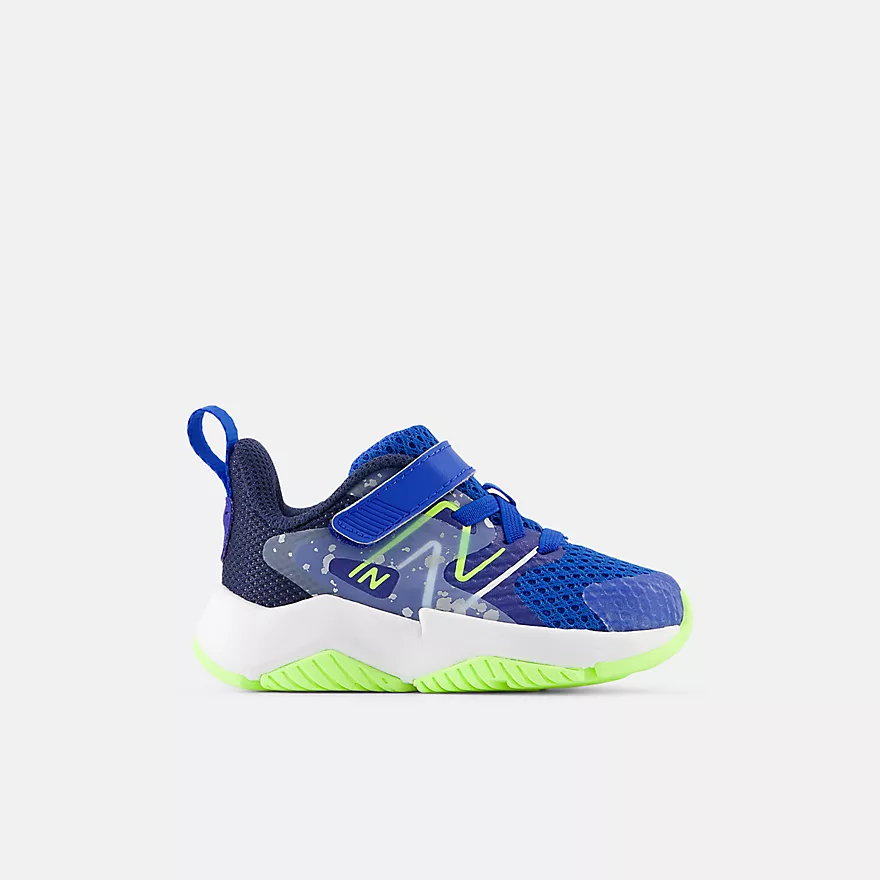








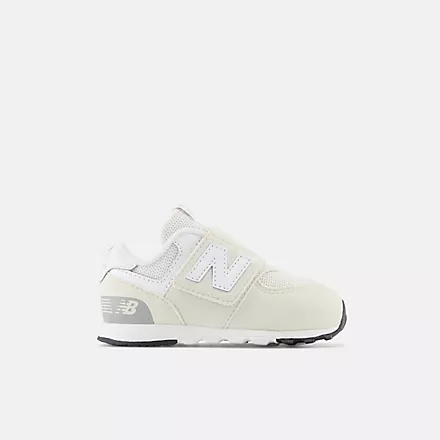


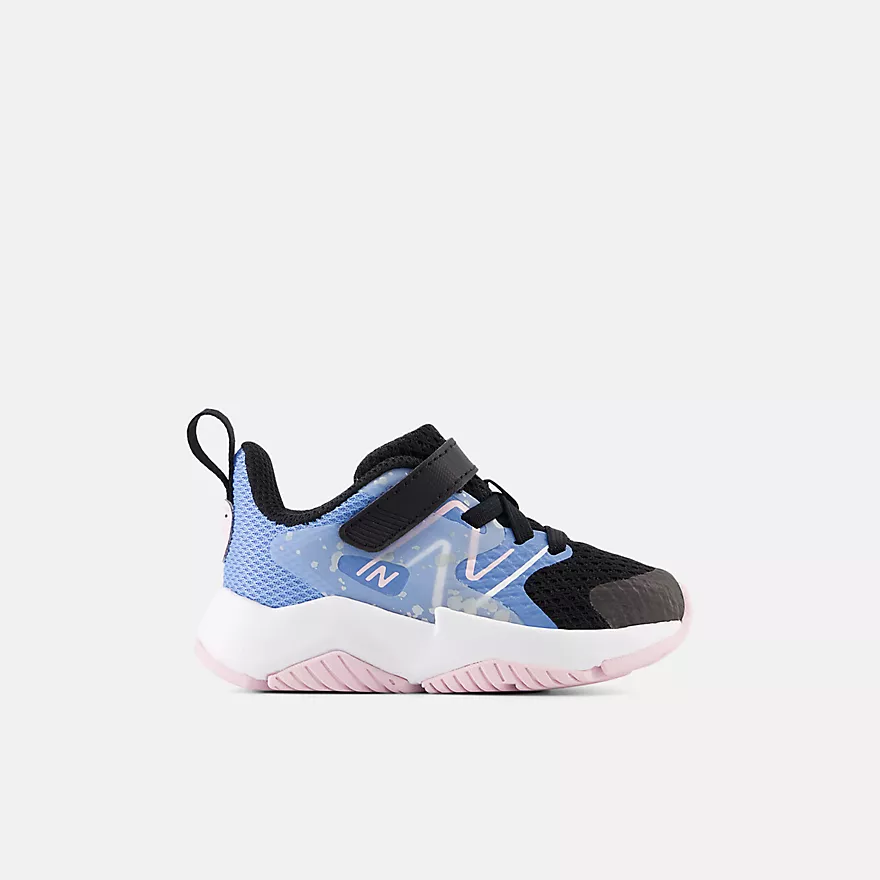


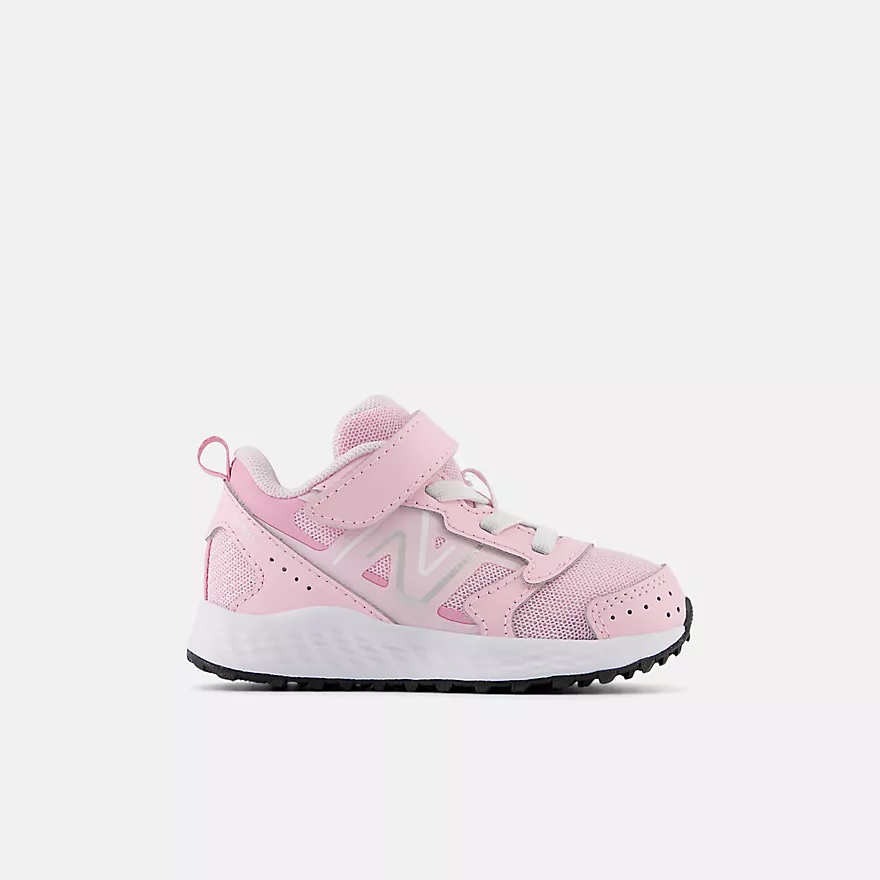


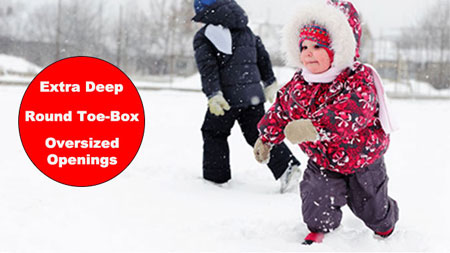
My grandson will not let you put shoes on him any kind of shoe he gets very distressed and cry’s and you have to take them off. Any advice us welcome ?
Hello Patricia,
The first step is to make sure that your grandson’s shoes are big and wide enough for his feet. Are you sure that you ordered the shoes in the correct size?
If you are unsure of your grandson’s foot shape and length you should follow the instructions on this article:
How to Measure Your Kids’ Foot – 2 Simple Steps to Determine Foot Length and Foot Width
My daughter was most of the time barefoot at home. She started walking on her own at 10months. I agree that shoes hinder their ability to take control of their balance. Putting on shoes too early will give certain restrictions because they don’t feel the ground as normal as they would feel it when they are not wearing shoes. Therefore, the delay in walking on their own. I started letting my daughter wear a soft soled shoes everytime we are out but at home, barefoot is the most advised.
Pitin,
Having our children walk barefoot at home is the best thing we can do for them in order to promote healthy foot development. Putting shoes too early won’t restrict them in any sort of way, we just won’t use the shoes at home, we will just use them as foot protection when they go outside.
Hi and thanks for the helpful tips. 2 questions though, do you recommend shoes with some sort of arch support for toddlers? Also, when buying shoes for toddlers, I tend to want to buy slightly bigger shoes to allow free toes movement and also they grow so fast. Is there a leeway guide on how much bigger the shoes you can buy because if you buy too big a size, I am afraid the little ones might trip.
Norman,
Don’t confuse toddler shoes with infant shoes. The page you are reviewing describes infants shoes and these do not provide any sort of arch support. The baby shoe has one fundamental function: to provide a simple protective housing for the foot to allow the foot to develop in its own natural way
For toddlers (a child that is between 2 to 3 years old) the shoes have definitely more support but not a pronounce arch.
Do not buy shoes that are too long. You might be thinking that you are saving money but it is actually the opposite. You will be compromising your child stability and make him/her more prone to falling and hurting themselves.
Great article for new parents! What type of shoe do you recommend for a teen who’s feet turn in? He’s a bit pigeon toed 🙂
Lori,
I would recommend either the KJ990 from New Balance or the the Gel Noosa Tri 10 GS Triathlon from Asics. If he is turning in after wearing these type of shoes it means that he will need orthotics with his shoes.
First of all what a really nice site. It’s so genuine it seems as though you really care for small childrens’ well-beings which creates trust for many parents out there. I do not have any children but I have been raising a now 8-month old girl who loves to walk around in her little walker. I believe it is time to take her outside rather than keep her secluded in the house. I’ll be sure to mention your article to my sister(her mother) so that she can better choose the right booties for baby. Thanks for creating this!
I am glad you found the post informative. I do love and enjoy the opportunity to work around children and I always make sure they leave the store with the best pair of fitting shoes.
This is the exact article I should have had 11 years ago with my first born son up until now when picking the types of shoes for him to wear.The good news is I have a one year old daughter and 6 year old daugther to use this wonderful information for when selection their footwear.Was wondering if you have any info in regards for picking out what type of clothes to wear for each season?
Yours Truly,
Carlton
Carlton,
My expertise is only in children and adults shoes. I do not have any experience when it comes to clothing. Thank you for stopping by.
Hey Juan, great post with very relevant information. I totally agree with you that leather soles are the best for baby’s first shoes. Here in South Africa is a brand of baby shoes called Pitta-Patta and they are amazing for baby’s first shoes just very expensive of course.
I never considered that children are very hard on their feet, it makes perfect sense though reading your explanation of how kids jump, skid and bounce all over the place. My daughter just turned 4 years old and I am struggling to find a pair of hardy shoes. She loves all the pretty sandals but they last like 2 weeks with her!
Lynne,
I will do further research on that brand you mention. I am sure she loves the pretty looking sandals, she must be a fashionista. Keep in mind those pretty looking shoes might not always be the most supportive ones, specially if she is going through them so fast.Thank you for stopping by.
Nice article. I can relate to this. I have a 10 month old daughter she is not walking yet. But she is crawling and standing up on things a lot with ease, I know she will be walking soon I actually cant wait to see that day were she is just walking around. I am going to get her some shoes as well. Nice article keep up the good work I really learned a lot here.
Brandon,
I am glad you enjoyed my post. How exciting that your daughter will be walking any day now. Thank you for stopping by.
Thank you for your info Juan! It was really good to learn more about the main points to consider when thinking about children’s shoes. Your article made a lot of sense!
The idea of having the tot in bare feet as much as possible at home was great to hear and again, made natural sense. Don’t think I’ve ever heard of the theory of the child walking as soon as they are put in shoes! What you say about them being ‘confused’ by them and freezing up brings back some very vague memories of trying to get used to sandals as a kid. …It’s just not natural at first is it!
A fantastic and helpful article thanks a lot!
Jamie,
I am glad you found the post informative and that it brought fun memories of you as a child. Thank you for stopping by.
I was searching for information about by 14 month old who started walking about a month ago. He does go barefoot around the house so we have done that right, but when we went to Clarks to buy shoes, they suggested some really quite hard bottomed ones, which he really does struggle to walk in as he is in barefoot most of the time. Do you think I should change these then?
Ruth,
Congratulations to your son on taking those first steps, like I mentioned in my post they are always the hardest. You have done the right thing by having him walk barefoot around the house and please continue doing so. I only recommend taking children to independent stores, these tend to have the most experienced shoe fitters. Is he stable when he walks? Is he on his feet most of the time? If he is, then he does need hard bottomed shoes to provide him with good support, since he is putting pressure on his feet. My main concern is whether his shoes were properly fitted,shoes that are too long or too short might also be the cause why he is struggling to walk.
Dear Juan,
The baby picture at the top of this Blog Post of yours is very cute. You bring a ton of good points here, that it is often most beneficial as a baby takes their few steps is to walk barefoot. Aside from the home, would taking them to the beach to walk on the sand help too?
The way I see it is that sometimes the floor could be slippery and the sand could potentially cushion them a bit if they fall.
You are right in saying that it is best for the child to wear a set of shoes by the time they go to the shop or other areas.
My parents often walk barefoot at home but I often find myself wanting to wear slippers at home. It is because as a child I had a piece of glass half an inch that sucked its way inside my foot and it stayed there for 3 years.
I shall surely convey this Blog Post of yours to a couple friends of mine who are first time parents recently. 🙂
Wishing you all the best with your online success above and beyond the horizon,
~Angel
Angel,
You actually bring an interesting point about babies walking on the sand. My take on this is that as long as there are not any elements in the sand(glass, shelves, pebbles, etc) there will be no problem of them walking on it. Any surface that is clean will be okay. Thank you for sharing.
This was a really helpful article with information that I feel we often overlook with small children. I feel as though a lot of parents with infants could benefit from this article. Additionally, the content is so thorough, that I can tell the author is really an expert in finding the right pair of shoes for any individual.
Robin,
Thank you, I do love what I do and take my job very seriously. I am glad you found the article informative.